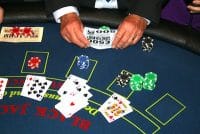Blackjack Game
Player's Hand
Total: 0
Dealer's Hand
Total: 0
Blackjack, often hailed as the king of the card tables, embodies the quintessential casino experience, combining skill, strategy, and a touch of luck. This game of intrigue and decision-making has captivated players worldwide, offering a blend of accessible rules and deep strategic complexity. From its humble beginnings to its current status as a casino staple, Blackjack has evolved into a game that appeals to both novice and experienced gamblers alike. This article explores the history, rules, gameplay strategies, and the enduring appeal of Blackjack, providing a comprehensive overview of this iconic game.
The Origins of Blackjack
The game of Blackjack, or “21” as it’s also known, traces its roots back to the French casinos of the 1700s, where it was called “Vingt-et-Un.” The game made its way to America in the 19th century, where it underwent several modifications to increase its popularity among players. One such modification was the introduction of a special payout for a hand comprising the Ace of Spades and a black Jack, which ultimately gave the game its modern name, Blackjack.
The Basics of Blackjack Gameplay
The objective of Blackjack is straightforward: to beat the dealer’s hand without exceeding a total of 21 points. The game is played with one or more standard decks of 52 cards, with each card assigned a point value. Cards two through ten are worth their face value, face cards (kings, queens, and jacks) are valued at ten points, and aces can be worth either one or eleven points, depending on which value benefits the player’s hand the most.
A game of Blackjack begins with players placing their bets. Each player, along with the dealer, is then dealt two cards. The players’ cards are usually dealt face up, while the dealer has one card face up (the “upcard”) and one card face down (the “hole card”).
Players must then decide how to proceed with their hand based on its total value and the dealer’s upcard. The options available are:
- Hit: To take another card in the hopes of getting closer to 21.
- Stand: To keep the current hand and end the turn.
- Double Down: To double the bet, take a single additional card, and stand.
- Split: If the two initial cards are of the same value, to split them into two separate hands, each with its own bet.
- Surrender: In some variations, to forfeit half the bet and end the hand.
The dealer plays after all players have made their decisions, typically following a strict set of rules: to hit on 16 or less and stand on 17 or more.
Winning Strategies and Counting Cards
While Blackjack is a game of chance, understanding basic strategy—based on mathematical probabilities—can significantly reduce the house edge. Players can use strategy charts that outline the best moves in any given situation, taking into account the player’s hand and the dealer’s upcard.
Card counting, a more advanced strategy, involves tracking the ratio of high to low cards remaining in the deck to adjust betting and playing strategies accordingly. While not illegal, casinos may discourage or prevent card counters from playing.
The Cultural Impact of Blackjack
Blackjack’s appeal lies in its unique combination of skill, strategy, and the potential for big wins. It has become a cultural phenomenon, featured in countless movies, books, and TV shows, often symbolizing the tension and thrill of casino gambling. The game’s simplicity makes it accessible to beginners, while its depth of strategy keeps experienced players engaged for a lifetime.
Conclusion
Blackjack remains one of the most popular and enduring casino games, offering a perfect storm of excitement, strategy, and accessibility. Whether played at a physical casino table or through an online platform, Blackjack continues to attract a diverse array of players, each drawn to the challenge of beating the dealer and the thrill of the gamble. As the game continues to evolve, its blend of simplicity and complexity ensures that Blackjack will remain a favorite among casino-goers for generations to come.


